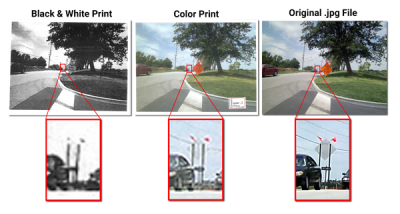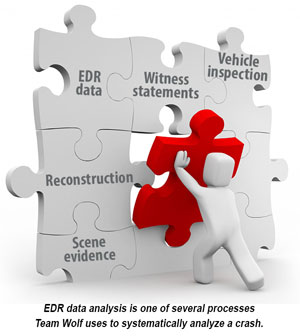Digital Media consists of scanned paper documents, photos, videos and audio recordings. A distinct advantage of digital data as compared to older analog data is that there is potential to make copies without modification or quality loss. Despite this valuable capability, we regularly receive digital media that has been destructively modified, resulting in the loss of critical data and/or quality. These modifications may be as simple as changing a file’s format or uploading it to an online site, or as destructive as printing a photo and then scanning it into a .pdf file. Although this processing may sound inconsequential, it can significantly hamper the work of an analyst.

Loss of critical data due to inadvertent processing.
With few exceptions, no one would ever consider modifying physical evidence. To preserve its integrity and usefulness, and to avoid evidence spoliation issues, digital media evidence needs to be treated the same.
The problems can be readily avoided by simply keeping the original files in their original format without any modification. For convenience copies can be made and altered, but analysts need the unaltered originals. When requesting digital media from outside sources, always specify unaltered copies made from the originals.
We understand that these issues are technologically challenging for many of our clients. We are always available to advise you on the best ways to protect digital evidence to ensure that we are best able to help your clients.
Digital media files often contain metadata, which is data that documents the conditions under which the media was created. Metadata may include date, equipment model, equipment settings and more. Analysts need this data to know under what conditions the recording was created. James Sobek, Wolf’s senior visibility consulting expert, explains that photo files “… contain metadata information as to actual time that each image was taken and the ISO, relative aperture (f/) setting and the exposure time for each shot. That will allow me to independently assess lighting levels.” In addition, as sources of video evidence continue to proliferate, forensic analysts and reconstructionists increasingly rely on it to complete their work.
The quality of digital media needs to be maintained. Often, files are reformatted or sizes are reduced to make it more convenient to transmit. Unfortunately, this process leads to data loss and may introduce undesired artifacts. Analysts must use their senses to study the media, and when the quality is degraded, their ability to do their work may become degraded.
Court exhibit developers need high quality source files to develop the exhibits that jurors need to comprehend. Tim Maher, media analyst and demonstrative evidence developer, adds that “Jurors need all the help they can get when trying to understand complex litigation issues. Compromised media files makes this process difficult.”
We understand that many people do not know how to avoid destructively altering digital media, so we offer the following tips:
• When you need to make copies of digital media for your analyst or exhibit developer, ensure they are unaltered from your source versions. If you are not sure how to make unaltered copies then ask them for assistance. If you need to alter them for your own use make copies and retain the originals.
• Simply copying files from one media to another should not modify metadata or quality. Posting the files to some file sharing sites will delete the metadata and reduce the quality. Inserting images into other applications (such as PowerPoint and Word) will destroy the metadata and significantly reduce the quality.
• Do not change anything within the original file. If you need to alter images by changing file names, adding text, cropping or resizing then make a copy first.
• When scanning documents or photos, use the highest quality setting with the least amount of compression. The default settings will probably not suffice. We prefer to do the scanning when we are working with a client’s prints.
• Other than possibly convenience, there is rarely ever a reason to change formats. If you have media that is stored in a proprietary format (such as video surveillance files) you may need them converted to a common format for additional analysis or processing. If you do, ensure that the highest possible quality settings are used. Note that most default settings are not the highest quality and you or your operator may need to review the manual. If you need a different format to use them on your computer, first see if you can add capability to your computer (such as new software). If not, be sure to preserve the original file to send to your analyst or exhibit developer.
• If the file sizes are too large for your existing technology to manage, you need to upgrade rather than compromising the integrity of the evidence. There are an abundance of resources available to store and deliver large files.
• When recording your own digital media, always use the highest available quality setting (which is unlikely to be the default setting). Be sure to bring extra data storage to ensure you are prepared.
If you need help with your digital evidence, contact Timothy Maher at 317-842-6075 or tmaher@wolftechnnical.com. We do not charge for initial consultations.
